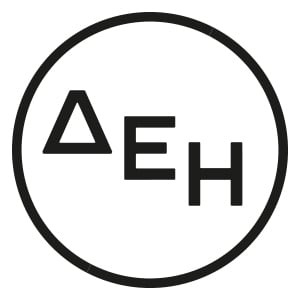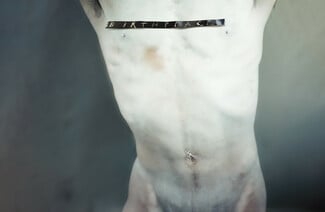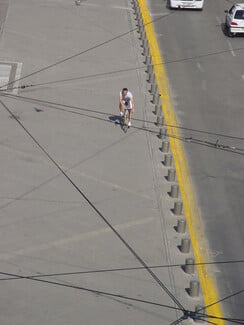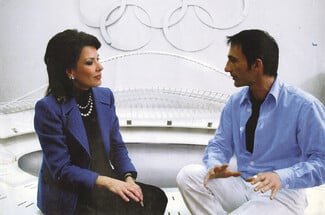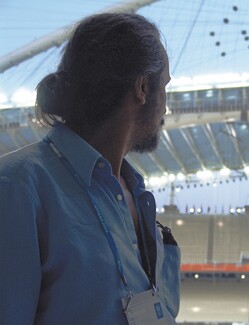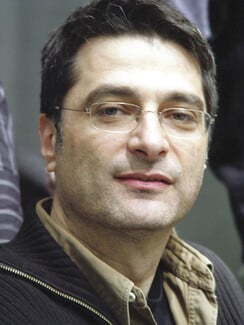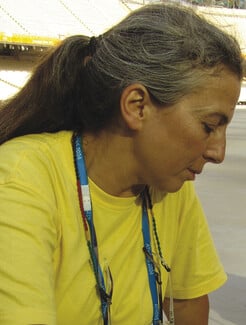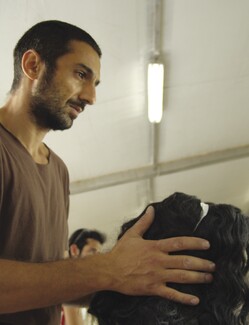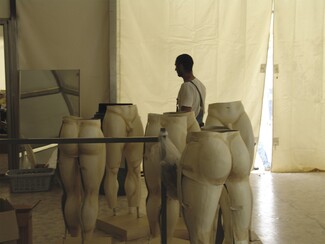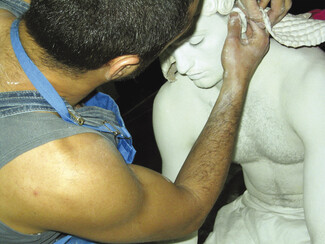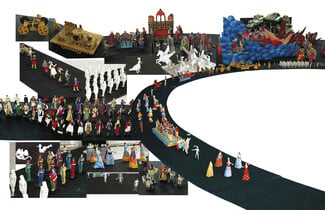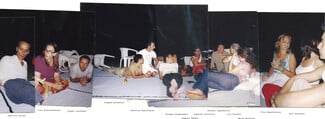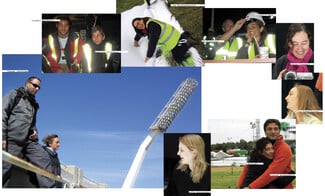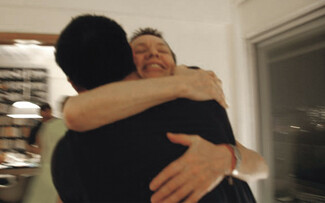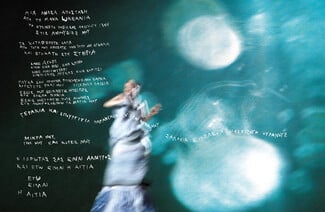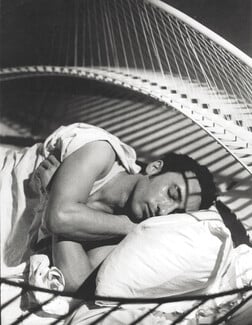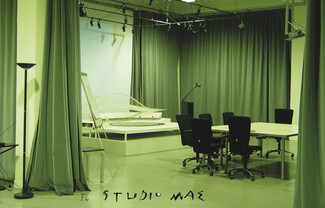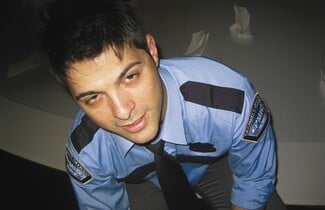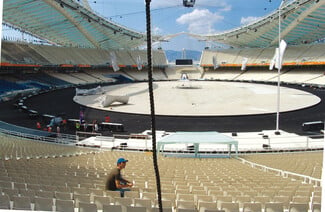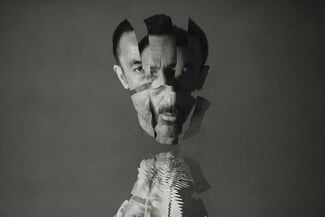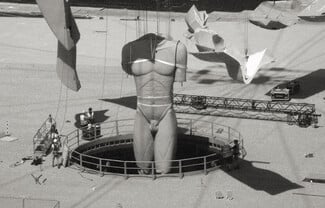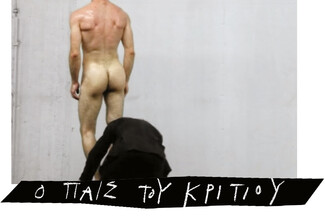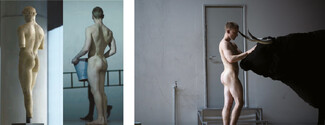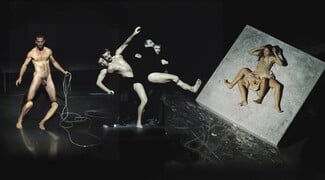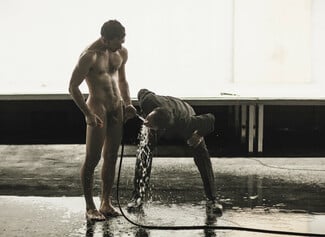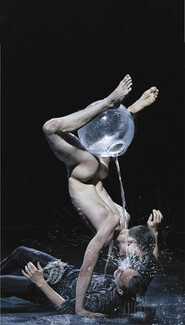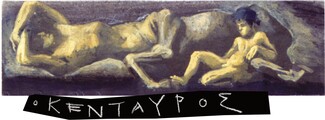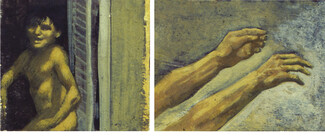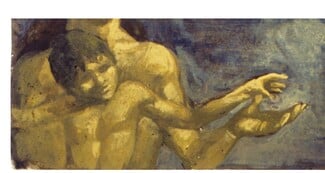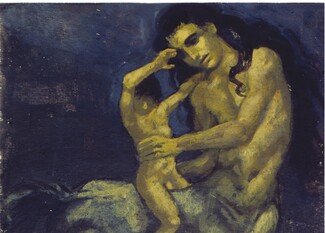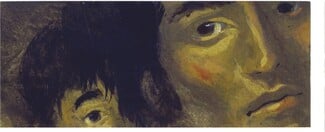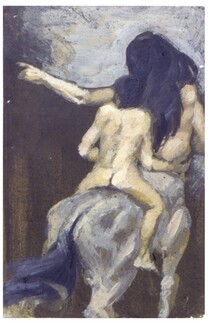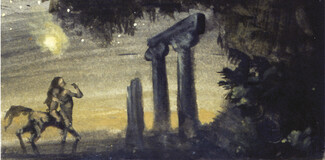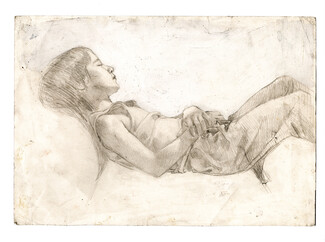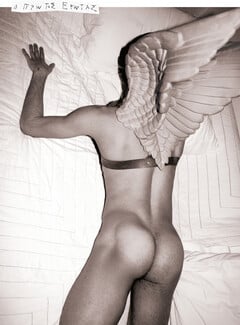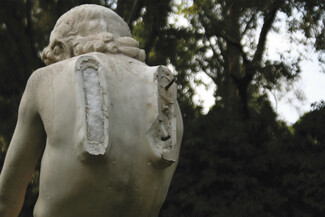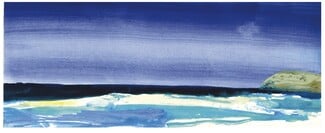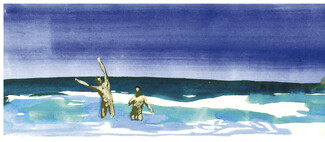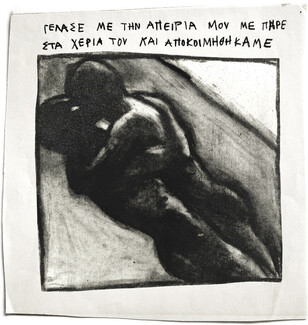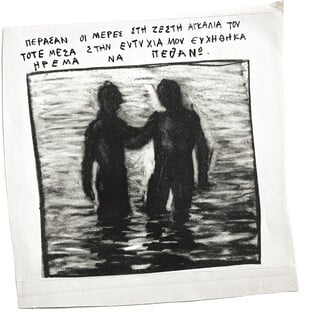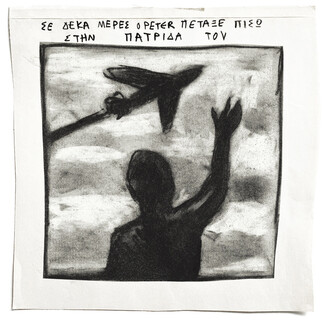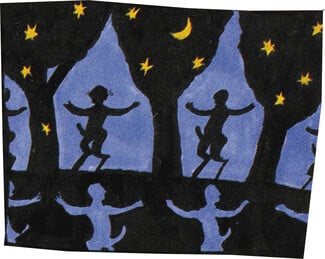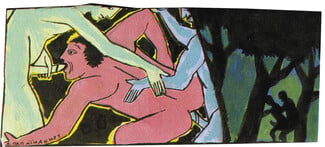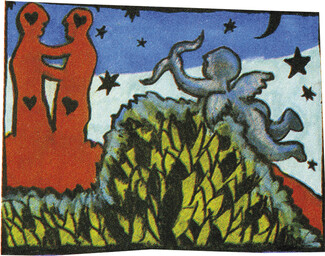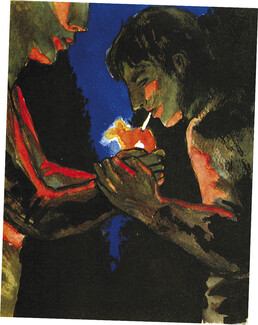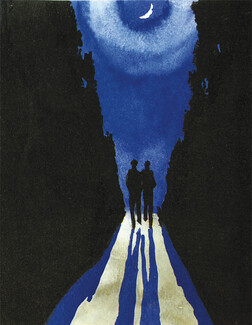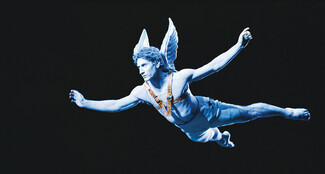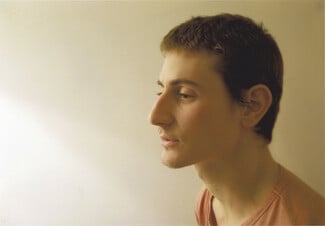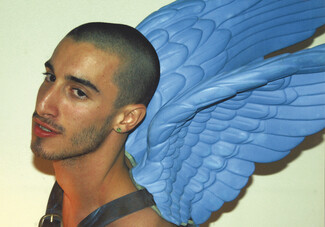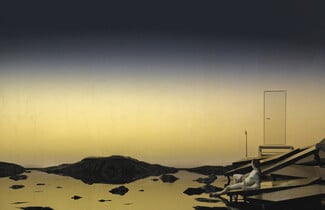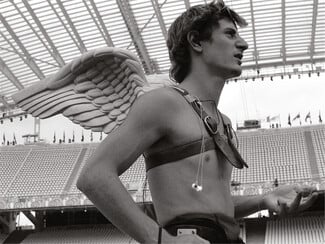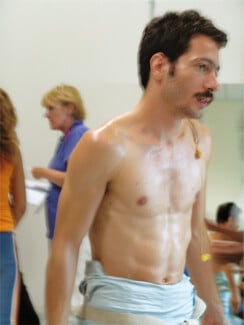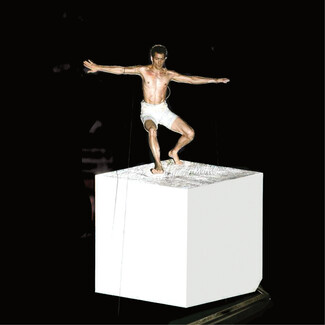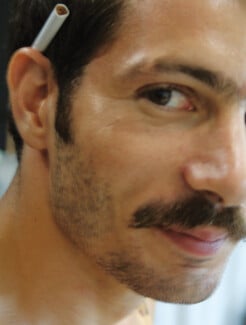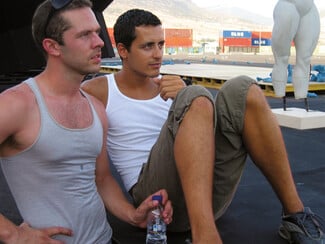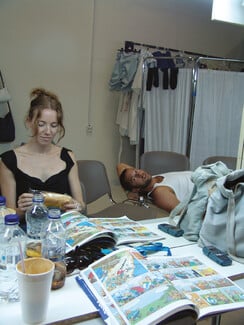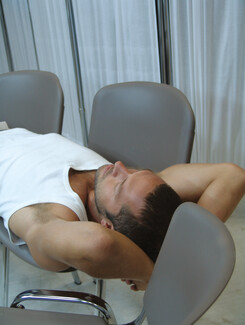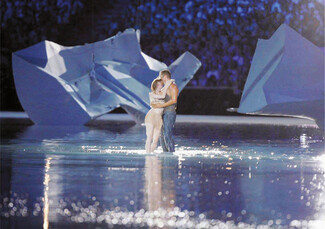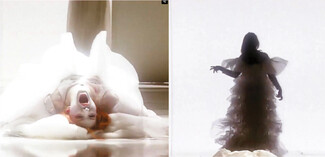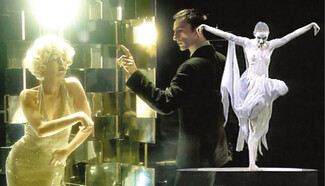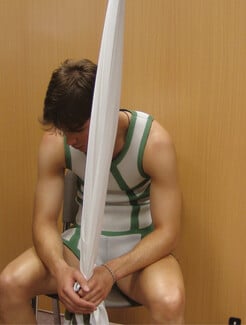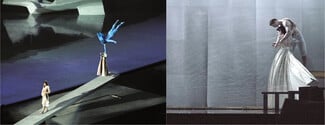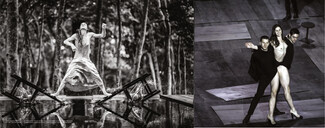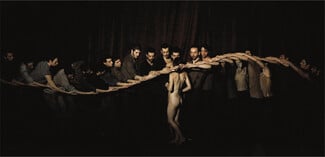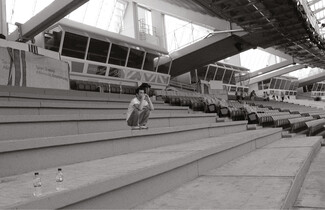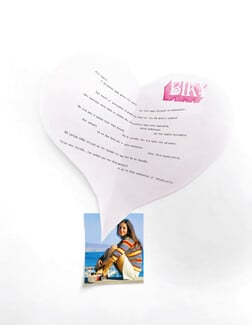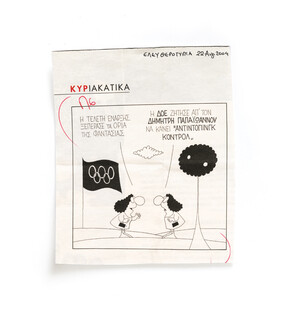
DIMITRIS PAPAIOANNOU / OPENING CEREMONY / 20 YEARS LATER








Photo / Artwork by D.P.
"Listen: Τhat August me and my family were just outside of Athens. My father was bedridden, in his final days, he had cancer, my mother beside him. I was almost 20. The air was heavy with the anticipation of grief. This is how we watched it. As soon as it ended, I went out into the garden behind the house, looked up at the sky, at the night, and said: Life is beautiful
I owe this to you."
I’m on my bike when my phone rings. It’s from "Athens 2004". They ask me to stop by. Marton Simitsek (Chief Operating Officer of the ATHENS 2004 Organising Committee) wants me to put together a proposal for the opening ceremony of the Athens Olympic Games. I request three months, a modest budget, and promise to present something. I gather the videotapes of the previous ceremonies because I had never watched any; the Olympic Games were never part of my life until then nor did I support the idea of Athens bidding for them.
I am 35 years old. It’s 2001.
I later found out what had happened: Vangelis Papathanassiou was the number one candidate to be assigned the ceremonies, having already laid the groundwork with his Mythodea. The ten-minute segment at the Sydney closing ceremony, where the upcoming host country (Greece) received the Olympic flag, was directed by him: Priestesses. The ratings plummeted, and Gianna (Gianna Angelopoulos - Leader of Bidding and Organising Committees of the ATHENS 2004 Summer Olympics) panicked. They started searching for an alternative and came across my name. I suspected who spoke to them about me. His name is Antonis Zaglakoutis, and he was already working in the Athens 2004 Culture Department. Antonis had been following my work, and when Athens won the bid, he confided his dream to me: that I would be the one to direct the ceremonies.
I begin sharing my concerns with close friends: Should I do it? Is it worth the effort? Is it worth the artistic and especially the personal risk? How much will it damage what I had built as an artist so far? Who will I be after all this? How am I connected to the Olympic environment, and most importantly, will what I design be realized in its entirety and delivered to the world as I envisioned it?
I had to respond to similar -though much less dramatic- dilemmas (I had already survived two Olympic scale opening ceremonies (*1, *2) when in 2017 I was asked to create the first original work for Pina Bausch’s Tanztheater Wuppertal, thus becoming the first artist to work with the legendary company after her death.
My friend Amalia (Moutousi) listens to me patiently one afternoon at Dionysos café under the Acropolis.
“Dimitri, it’s your destiny”, she tells me.
The videotapes lay on the shelf for ten days, under porn. I procrastinate. When I summon the courage, I start with Barcelona, which I know was the first ceremony in modern Olympics to be held at night with stage lighting and was still considered unsurpassed.
I watch it alone in the small flat I stayed at the time. As soon as it ends, the first thought that comes to mind is this: I don’t know if I can create something truly good, but I can definitely design something better than this.
I announce to Giorgos Koumendakis that Ι will not do it without him. We had a long history of creative collaboration. We were friends then. I respected him. He was much more educated than I, and the process of creation with him was always a strive for artistic excellence.
Giorgos accepts.
Tina Papanikolaou – my professional ally of over 40 years, born ready for demanding tasks, stands by my side and organizes my chaos. I ask Yorghos Matskaris, beloved friend, dancer, and teacher of Alexander Technique, to return from New York and undertake the research. We also needed a space to work. My friend Olia (Olia Lazaridou, renowned Greek actress and friend) offers her house. It’s funny. Her full name is Olympia.
The Twin Towers fall. The world changes.
The security of the Olympic Games will become a nightmare.
We are in 2001, and I am preparing for the premiere of For Ever, which was destined to be the final performance of the Edafos Dance Theatre; a more fitting name would have been Never Again. Angeliki Stellatou left the company just one month before the premiere. I am sad, angry, relieved and in panic. A seventeen-year-old partnership had come to an end. In For Ever I was directing and performing at the same time. I mention this for those who know what a nightmare that is; the rest of you ignore it.
Replacements, final rehearsals, lighting cues and I hit the ground. I faint for the first time in my life. A muscular spasm within my shoulder blade on the side of the heart. Rehearsals flat on a stretcher, a premiere with a distorted back and tons of painkillers. The past was making a spectacular exit! The future also needed work.
We dive into it. We study Greek art history, the history of the Olympic Games, the history of the country. The revival and history of the modern Olympic Games. We watch all the ceremonies, decode them, dissect protocol from the artistic part, defining the field where we could make a difference.
Not that it matters but I don’t think any other artist was requested to prepare a proposal. I still don’t know for sure; I never asked.
I knew from the very beginning what I wanted to do, but I had to ensure the validity of my vision. To visualize the concept into an Olympic-sized performance.
I prepare a presentation which is the sketch of exactly what you saw: Backbone, soul, and theōrēma all present without yet flesh, muscle and sinew.
You can see my initial designs and the final images side by side.
First encounter of the third kind
The first meeting with Gianna is a disaster. We almost fight. She left. We packed up and amused ourselves with the delusion that what we had dreamt of would actually be welcomed. We headed home.
I told Michael Cacoyannis, who was a friend and great supporter, although he himself wanted to direct the ceremony, what had happened. “Do not be surprised if she ends up being your best friend,” he tells me.
Gianna and I are two completely different animal species in the jungle. In our world, she seemed like an extraterrestrial drag queen to whom we reported to, whom we had to respect, and who was an endless source of amusement and terror. That Halloween, I held our creative meeting wearing a mask of Gianna’s face that was on sale in every kiosk at the time.
When Socratis Socratous visited our first offices, he took a photo of us. That same evening, while looking at the image on my screen, I impulsively swapped our two heads and found it very fitting. John Waters would have been proud of me.
My team loved it.
The two jungle animals sniffed each other out and joined forces for a common purpose. We both wanted the same thing: success.
Even with different perceptions of what that was. Over time, the self-sacrifice, devotion, targeting and monstrous endurance we detected in each other created an atmosphere of acceptance and bonding that in our overwhelming exhaustion momentarily seemed like love. Nothing compares to the uphill climb of the Olympic Games.
Back to the sequence of events:
The same afternoon of our disastrous first encounter, I receive a phone call, “The President has some questions and wants to see it again!” We present again a week later. Theodoros Angelopoulos and Michalis Zacharatos, General Manager of Communications, are present. Gianna is absent. Michalis buys it. The mood is civilized.
And then silence. I let weeks pass before calling Simitsek to say, “I got it and therefore I ‘ll go ahead and plan my next work.” “No, I want you to wait for us; I’ll offer you a salary, and you’ll wait.”, he replies. About a month and a half later they get back to me: “Pack up the entire presentation and we will take you and your team in secrecy to Salt Lake, host city of the Winter Olympics. We’ll invite the Immortals to view it in absolute confidentiality.” Yes, you heard correctly: The members of the International Olympic Committee are called “Immortals”. They die, of course, like the rest of us. This “confidentiality” thing was big in the game. We all signed NDAs and made others sign that there would be penalties if anything was to leak.
It was a kink. We got off on the idea that our work was terribly important, like a state secret.
So in a surreal dream, we find ourselves at a secret location in Salt Lake surrounded by ice and Mormons setting up the presentation. That afternoon, Gianna and the Immortals arrived. Gianna dressed as a dominatrix-hunter: black patent leather high heels, black leather pants, and a short fur Hasky-type top with a detachable matching collar. “I hope you are ready,” she exhales as she passes by.
In the darkness and the calm vibe of the presentation the Immortals relaxed, some even dozed off, but that did not prevent them from applauding warmly, giving me a standing ovation. “Greece deserves this and nothing less”, I overheard them say. For the first time, Gianna approached me discretely, reluctantly offered her hand for a handshake and said verbatim: “You know me, I never allow myself to get emotional, but I must admit that this was a good effort."
Cut two years later, a few weeks before the opening, in a tête-à-tête meeting, I present her the 3D rendering of the flying Cycladic fragments choreographed to Mahler's music, and Gianna cries.
We packed up and returned to Athens. My friends greeted me with a surprise party wearing beauty pageant sashes: Miss Crete, Miss Messolonghi, Miss Sparta, Miss Mani, etc. Under Koumendakis they had rehearsed to sing the Olympic Anthem. We drank, got high and celebrated what seemed like a success.
Indeed, after some time they called back, and on a sunny day I head to the offices of "Athens 2004," where Gianna tells me: "I am pleased to assign you the opening and closing ceremonies of the Athens 2004 Olympic Games." She wore a super mini Chanel suit in parrot green, matched with orange lipstick and white pumps. She uncrossed and crossed her legs. Basic Instinct.
I find out the initial budget of the ceremony (which I am sure was largely exceeded) and calculate that a 10% fee would be fair for its creator. The amount is astronomical for my standards at the time, but I decide to claim it. I know that the Olympic Committee will own all the royalties and that I won’t get any percentage from the countless broadcasts around the world or from the sales of the DVD and images. While waiting outside Simitsek's office, I double the amount in my head. I go in, claim it and get it.
My appointment as director of the ceremonies is publicly announced. My fellow citizens are on board and very happy; the Organizing Committee is taken by surprise. This gives me bargaining power. It will come handy.
I close down the Edafos Dance Theatre company.
My Champions
My next move was to form a creative taskforce, a team of artist commandos. Back then an entire generation of stars was shining in the Indy art scene which I also derived from.
Giorgos Koumendakis would co-sign the concept and create the musical script. Tina Papanikolaou would coordinate the artistic creation with the collaboration of Yorghos Matskaris. Together with Kali Kavvatha, they would create a powerful shield of support around me.
Lili Pezanou, a beloved and tireless associate, would implement the scenographic concept.
Lina Nikolakopoulou, a beloved poet, would oversee the creative copy.
I ask Yorgos Lanthimos – who had not yet made even his first feature film – to join the team so that we can have an understanding of the broadcast. This ceremony is primarily a televised event.
I ask Dimitris Korres, genius engineer, to join us to determine the technical feasibility of my absurd dreams.
Eleftheria Deko would handle the lighting while seeking a colleague with Olympic and Broadcasting experience. They would design together.
Despite the fresh wound of our breakup, I ask Angeliki Stellatou to oversee all physical human movement.
Eleftheria questioned if this was a good choice, given that such a challenging endeavor would not permit risks of emotional entanglement. Tina told me: "No one else can deliver the quality of movement you seek." Tina was right.
Angeliki forms a team of dancers who -loyal to the method we had implemented in the two operas I had directed- would assist her in artistic research, finalize choreographies, under her guidance, conduct auditions, allocate volunteers according to their skills, teach them the choreographies, and perform with them on the big day.
Along with Lanthimos, and following Eva Stefani’s suggestion, we invite Athina Tsangari to document film-wise the entire three-year journey. Athina joins with enthusiasm and expansive tendencies. A year later, she directs the ceremony’s videos together with her inseparable associate, Matt Johnson.
Koumendakis brings the pianist Maria Metaxaki to the team – together, they will put out many fires.
Eleftheria brings us Bob Dickinson, who with great professionalism and tenderness, raises the level of lighting. Our ceremony used the most lighting fixtures in the history of entertainment up to that point. It broke the world record. The two of them would win an Emmy.
With the same artist, I would work 10 years later on the first European Games, which would bring him another Emmy. Recently, he sent me a message saying that he missed me and wished we could work together again; "Bobby wants another Emmy.", Tina said.
I had never met Sophia Kokosalaki, her star had just risen in the London fashion scene. I asked to meet her and when we did, she was skeptical. However, she agreed to join the creative team and take on the costumes. Midway through the process, she was struck with cancer for the first time, but continued to work throughout the chemotherapy. She never lost her sense of humor. I loved her. Before our ceremony aired, in an interview for French Vogue (if I remember correctly) when asked about me she said, "The first thing one should say about Dimitris is that he is a very good person." To this day, she’s the only one who has spoken of me in such a way. I hugged her for the last time at Sadler's Wells in London, when she came to watch The Great Tamer. Claustrophobic and agoraphobic, just like me, always seated at the edge, ready to leave. Shortly after, we learned of her death.
For the fireworks design, I avoided the Angelopoulos couple's suggestion for the American company and preferred Christophe Berthonneau, the French artistic director of Groupe F.
One must never underestimate the design of Fireworks: it’s the moment of ejaculation. The entire event is organized around a collective orgasm whose climax is fireworks.
We preferred the elegance of a French ejaculation.
That same American company set fire to Filothei with their fireworks at Gianna’s reception one day after the ceremony. I dodged a bullet. I’m convinced that one should ask for what one believes to be right even if it’s not always granted. One should always ask. You only regret the things you didn’t go for in life.
I ask Nikos Alexiou to define the sizes, proportions, and incisions of the sculptures of the Allegory. Nikos, who has passed, is one of the greatest artists of modern Greece. The National Museum of Contemporary Art should organize a massive tribute in his honor. But our country doesn’t give a shit about us, its contemporary artists. With Nikos, we were then in court over Medea, but the occasion was of a greater importance than our personal disputes. He creates a stunning model of the Stadium and the Calatrava roof, entirely made of bamboo. Today, it’s packed in one of the warehouses somewhere where everything sleeps in oblivion.
Athina Tsangari suggests to Socratis Socratous to photograph our monumental preparation. Socratis does it as a volunteer. He dedicates himself to the project obsessively, delves into everything, and captures all the beauty and sensual pathos in a unique way. It’s a pity that no one has yet published a collection of these stunning photographs. In this edition, I curated an album – as extensive as possible – for your enjoyment. Delve into it at the end of the article.
The Crown Jewel
Finally, I ask Angelos Mendis to undertake the creation of Clepsydra, the segment of the ceremony where images of Greek art glide through the Stadium in a dreamlike procession.
We were friends then. Angelos was a costume designer and makeup artist from another planet but had never attempted anything of a larger scale nor had any experience in directing. I don't know if it was instinct or love that drove my insistence –I had to persuade him– but this was the most defining decision in the formation of my ceremony’s artistic identity. Angelos accepted and exceeded every expectation. He proved his genius by turning the piece I assigned him into the jewel of the show.
He formed and led a team with key figures painter Maria Ilia, sculptor Nectarios Dionysatos, and set-costume designer Eleni Manolopoulou. For research he recruited Manos Lambrakis and Antonis Galeos. He took the most daring decisions and implemented them admirably. The universe he created by unfolding the entire history of Greek art before our eyes left everyone speechless. Anyone who saw it up close was gobsmacked.
The European and American TV directors during dress rehearsal placed additional cameras and begged us for ten more minutes – phenomenal airtime – in order to capture Clepsydra’s details on screen.
They had already seen Angelos' stunning model one year before but apparently could not believe that the realization would be precise and better. "Give them 10 minutes," Gianna asked me but it was too late. Everything was already timed, and the four hours of the opening were wound like Swiss clock.
The unparalleled level of Clepsydra, was also achieved though Angeliki Stellatou's unerring simplicity and insistence on the quality and detail of movement. She brought Mendis' images to life with a grace and underlying tension rarely seen. I am particularly moved when I think about the sacred sexuality with which the Snake Goddess led the dance. This same sacred sexuality was the most dazzling feature of Angeliki herself when embodying the personas I created for her over the 17 years of our collaboration. Angelos and I had dreamed that Angeliki would be the one to perform as the Snake Goddess, but her role compelled her to be in the "cockpit" counting for the volunteers the night of the show. Katerina Skiada was wonderful.
Konstantinos Vita (aka K. BHTA) was the third bright star in the constellation of Clepsydra.
The rhythm he invented and the way the sounds and ways of Greek music were engulfed in this rhythm transported us to a future that was at the same time primal. His piece is called Τhe Passage. Have a listen.
Two years later, Konstantinos would bless my creation titled 2 with his music.
Unfortunately, we didn’t get to enjoy the music during the live broadcast. Alexis Kostalas' (iconic commentator of cultural events and ice scating competitions ) chattiness deprived us of the experience. He never stopped talking. What a pity. To this day, I haven't managed to watch the entire ceremony with his commentary. I know it was done out of love, which turned into verbosity, but what's the use? He took a dump on a stellar moment when the immense talent of three of my most beloved people was being communicated for the first time with the world: Angelos, Angeliki, and Konstantinos.
Taking a piss
We get down to work.
The first year passes with the development of the basic concept and the search for a production company to organize and materialize it.
We set camp in the Stadium on 13th of August, exactly two years before the launch; we time itineraries, play music, drink, and dream.
I secretly head to the center of the Stadium and take a piss marking my territory like a dog.
Jack the Ripper
We create the Stadium model and select the production company through an international bid.
This is how our adventure with Jack Morton begins. It was a very tough and confrontational partnership until the delivery of the project.
Fortunately, thanks to an ingenious move by Gianna, the artists' contracts are drafted directly with the Organizing Committee of "Athens 2004." The result: We do not report to the production company.
I don't want to bore you with these details, but it's important to understand this: what usually happens in these gigantic productions, where millions just fly around, is that a production company hires the artists, makes a flashy presentation, gets the job, and then cuts on quality execution, selects manufacturers taking kickbacks, and profits endlessly.
I experienced this identical scenario once again at the European Games.
When the artists are employees of such a company, they are powerless.
I had them dancing to my tune. Both times.
At the mention of my name, I’ m sure they will foam at the mouth. But their showreels, display my images first.
Oh Superwoman
As the creative director of such an event, I am in a unique position. I can knock on any door.
I choose to knock on Laurie Anderson's. I am in New York, and this enormous, petite woman, who I’ve admired for years opens the door for me. Her broad smile welcomes me. I propose we collaborate. I want her to join the creative team and be the voice that greets the world to the Stadium. I also want her to direct one of the ceremony’s segments.
This is the beginning of an important relationship for me. Laurie comes to Athens and joins our collective dream. She visits the workshops of Mendis and Alexiou and is amazed by their models. She immediately grasps the free, non-corporate spirit of our team and gets onboard.
I witness with joy, an enthusiastic friendship develop between the two poets I have brought together. Nikolakopoulou and Anderson adore each other. They often laugh like children. Lina is always ready to turn into a three-year-old kid. A super popular reformer and a high priestess of the avant-garde.
It's touching how the core is the one. Laurie wants to try the Aristotelian Peripateric (Walking) method of Philosophy; she hires a "Walking Producer" (a term invented at that moment and used exclusively, I imagine for that occasion) and walks with Lina to Delphi.
Laurie Anderson, Amalia Moutousi, and Olia Lazaridou – I dream that these three voices will greet the world at the ceremony in the three Olympic languages. They workshop together.
Dimitris Korres arranges with his brother, the renowned Acropolis Restoration Director Manolis Korres, to take Laurie to the Acropolis. We get access to the Parthenon.
Emotions are immense yet when you experience them things feel normal. Thirty years back, at my mother's hair salon, I’m sent to fetch drinks from the kiosk. Twenty years back, I ran away from home to study painting. Ten years back, I was staging Medea and moving from the Artists’ Squat to the grand theaters. Now I am inside the Parthenon with Laurie Anderson.
She’s the one who will give me the hardest time. She will ask me the toughest questions, prove the most difficult to convince.
This process forces me to become clearer, to build arguments, and to defend my ideas more decisively.
However, Laurie kept postponing making decisions, hesitating to record. She kept delaying defining her role in the ceremony, so at a critical juncture, I called her, and told her that due to alleged budget cuts we should end our collaboration. She understood. She was probably relieved.
Artists of this caliber have difficulty becoming a “cog” in such a system. An Olympic Games opening ceremony is propaganda for the host country. This is its nature and mission. These ceremonies cannot be realized without artists, but they are not works of art.
This very notion of propaganda creates uneasiness.
I however, did not struggle at all; I had to speak positively about something that the more I studied, the more I realized I loved: my country, its narrative, its art, and its unapologetic obsession with beauty.
Chaos, corruption and madness are clearly visible in front of me.
But this was not the time. This was a time for a celebration.
Salty Sweat
Another door I knocked on was Björk's. For me she embodied the perfect hybrid of -avant garde and pop – precisely what I hoped our ceremony would achieve. I decide to ask her to write our Olympic song.
I had to fight for this choice.
I am particularly proud of this song.
In a hotel in New York, I secretly present the entire concept to her. Björk, is serious and thoughtful. I ask for something very specific: either to write a song or sing John Lennon's Imagine.
After a while, she informs us that she will write a song. We meet again in London, sit on the floor and listen to a melody she considers suitable, calling it "Mediterranean" because it has more passion than what she usual produces.
I showed her a Stadium transformed into the Mediterranean and she chose to sing as the sea.
I had envisioned her singing six-meters tall. The sea-dress created for her by Kokosalaki would cover the athletes revealing an image of the globe printed on it with its continents made of salt. Elevated, she would stand in front of the large screen, and behind her five jellyfish would fleetingly form the Olympic rings.
from Mother Oceania
your nimble feet make prints in my sands
You have done good for yourselves
Since you left my wet embrace
And crawled ashore
Every boy is a snake, is a lily
Every pearl is a lynx, is a girl
Sweet-like harmony made into flesh
You dance by my side
Children sublime
You show me continents
I see islands
You count the centuries
I blink my eyes
Hawks and sparrows race in my waters
Stingrays are floating across the sky
Little ones,
my sons and my daughters
Your sweat is salty
I am why, I am why
I am why
Lyrics / Björk Gudmundsdottir, Sirgurjon Birgir Sigurdsson
But the hydraulic system that would elevate her jammed and the poor thing remained grounded. Sophia was inconsolable; so many workhours, so many yards of fabric, and no one ever saw this dress! See it here in a picture from the dress rehearsal.
Of all the technical fuckups that could have occurred, this was the only one that could not cause a chain reaction of total chaos.
Such a shame; it would have been a stellar moment, but that’s life.
To all this beauty, gathered from every corner of the earth at her feet, to all these young men and women, the top of the crop from the caste of athletes who would sweat rivers in the coming days, Björk chose to sing as the sea/origin of humanity. And her song ends with:
"My sons and daughters
Your sweat is salty
And I am why"
When I read these lyrics, I was shaken.
Maybe no one paid enough attention, maybe no one agrees with me, but this is the most beautiful Olympic song of all time. (Three days after this article was published The Rolling Stone Magazine hailed Bjork’s performance as the best in Olympic history).
Listen to it again.. Read what Björk sang at our ceremony:
The Final Stretch
We move from our office in downtown Athens next to the Stadium. The new studio is spacious.
Giorgos Koumendakis brings Mahler. His music became the soul of the opening, the soundtrack of the Allegory.
Lili Pezanou creates her masterpieces. Thanks to her unmatched comprehension of modernism, she wonderfully designs the staircase that will rise from the stands to the cauldron, the edge of the sea with a slope that will allow the water to resemble a shore, and together with Konstantinos Kypriotakis, they sculpturally design the inner side of the fragments.
Athina Tsangari grants us a greeting from the NASA space station.
Roula Pateraki undertakes directing the three voices that will welcome us to the Stadium. Aglaïa Pappa in French, Olia in Greek and Amalia in English.
Koumendakis has the bold idea for a DJ set for the parade of athletes. He brings Tiësto.
Giannis Moralis (great contemporary greek painter) honors us by designing an olive branch for the runner's flag.
I appoint Lefteris Drandakis head of all matters concerning Greek cultural heritage and the Lyceum Club of Greek Women.
Irene Pappas, who was to be the Woman with the statue in her hands quits, so Lydia Koniordou will speak the words of the poet Seferis.
I persuade Santiago Calatrava to scale down his megalomania and incorporate the cauldron into the roof instead of outside the Stadium.
Pina Tours
I take the team on a trip to Istanbul to see Pina Baush's Nefes. Many had never seen her work before. An experience with Bausch's work is rehumanizing. The immense value of her art lies not only in what it is but in what it does to you. I am moved. I begin to realize the sentimental detachment of what I have designed and conceive the moment of the two lovers.
We go to Harrogate to conduct a technical and lighting test in real scale. On the monitors the imagery of the Allegory appears black and white. I conceive the red Centaur, a presence that will make the black and white decisive and solid. Simultaneously, I envision Eros to be blue.
Degas και Benzogal
Exhaustion hits the roof, my immune system declines and in a carnal chaos I contract scabies! My skin itches everywhere.
Disinfections, sprays, and Benzogal. To my bad fortune, this happens the same week I’m invited to Gianna's house for the first time. I must impress and charm the television directors of the ceremony. I purchase my first suit – I never needed one till then– slather myself from head to toe in Benzogal, and though I arrive just in time despite the downpour, as I get out of the car, I hear a rip! The entire back of my pants had torn.
In this delightful state, I spent the evening sometimes wall to wall, sometimes sitting, sometimes standing with my hands clutched behind me while admiring the original Picasso and Degas.
The Ring
I have a dream one night: I look down at a sea which flows like a river. It's like being at the Corinth Canal. My ring slips and falls into the rushing water. I feel that something is final. Loss accompanied by relief. I tell Olia. She still remembers it.
3D Choreography
We hire 3D designer Nikos Makris. I begin to obsessively choreograph every detail of the set movement. The aerial routes of each fragment, the route of the fire on the water surface until the formation of the Olympic rings, the rise of the olive tree, the ascent of the staircase, the speed with which the cauldron bows to the torchbearer. Everything precisely timed to the music within the 3D environment. Nothing left to approximation. The engineers have never seen such an obsession for accuracy.
I reserve for myself the choreographies of the main characters: The Two drummers, the paper boat Child, the Woman holding the marble head, the Centaur, the Man on the cube, the Lovers, the entire journey of Eros over the Clepsydra (here a combination of 3D choreography of suspension parameters and physical choreography is required), the Pregnant Woman, the Runner, the Torchbearers.
Giorgos Koumendakis also retains two scenes for himself: he composes music for the Lovers and for the Drummers’ Dialogue.
Amid all this chaos and thousands of coworkers, in these two small but crucially significant moments we were once again an artistic duo. Just us. The two of us.
Everything accelerates.
Arms Trade
The partnership with Jack Morton is a real war!
The turbulent seas of this great journey were particularly dangerous, and I had to pretend to be the captain without knowing how. But I was in a state of frenzy. I had to sink or swim.
Whatever calmness, negotiation skills, and endurance I had at disposal, were put to use.
I had to dance around enormous political, corporate, technical, and artistic Egos (my own included). Yuppies everywhere! I’m grateful to my parents who, although poor, had sent me to the American College of Athens with great sacrifices. In my time, this school fortified you with the most potent arsenal to achieve your goals.
I present, negotiate, adapt, and find myself in the eye of a cyclone I avoid thinking about.
I chain smoke, lose weight, redesign, and keep it together.
Haris Botsios, our close associate from Aktor, who worked on the implementation of the Calatrava roof, once gave me one of the most bizarre compliments I've ever received. One day on my balcony, he said: "I admire you, Dimitris; you're wasted in art; you should be a weapon dealer."
My father on one side and my mother on the other bring me supplies of homemade food every week. It's a truce: I had run away from home at 18, and they had divorced when I was 11.
With great effort I persuade Gianna to allow two dress rehearsals with a full audience. Michalis Zacharatos helps me out. She clung firmly to that damned confidentiality. Michalis, who has passed, was very close to her. He understood what I was trying to do and facilitated communications with her. He was a killer. One more jungle animal I would’ve preferred to see only from afar but had to work with closely. I felt he was dangerous but he was on my side.
Venia Papathanasopoulou, also close to Gianna, became our fairy Godmother. With wit and immediacy she solved any problem that could be solved.
The Calatrava roof is delayed, and our crucial rehearsals in the Stadium are reduced.
When we finally enter the Stadium, hundreds of parameters and thousands of people must be coordinated. Everything must work in sync. It's a balance of terror over chaos.
Technical rehearsals intensify.
Lighting rehearsals intensify.
The Stadium fills with the Games’ volunteers. They are our audience for the dress rehearsals. Through the PA system I ask them to keep what they see secret. They did. The media siege is suffocating.
The three sculptures come out broken in both dress rehearsals.
The chances of everything going wrong in this technological nightmare that I've designed are high.
Photo by D.P.
Friday the 13th
And the big day comes.
Scandal: Top athletes Kenteris and Thanou are caught doping!
Gianna calls early in the morning. I head to the Athens 2004 headquarters at the Hilton.
Kenteris, the ultimate runner star athlete, was the one supposed to light the flame. I had rehearsed with him exactly what to do and how to time the music. I had even asked him a favor –and with great tenderness, this “racehorse” with superhuman thighs had agreed– to run 100 meters with me and let me win! And that’s how I have a video where I outrun this legend.
We call Kaklamanakis.
We rehearse. Kaklamanakis is a sweet, beautiful man. "I'm terrible in running," he confides to me. But he runs.
The only compromise I have made is to dress the Pregnant Woman, despite the incredibly expensive and beautiful prosthetic we had designed allowing her to appear completely naked.
A gesture of respect to the Muslim countries participating in the Games despite that fact that Greek culture celebrated human nudity like no other.
We also covered the nipples of the Minoan Crocus Gatherers, whose fashion of the time wanted them topless. However, we left the Snake Goddess bare-breasted. Free the nipple!
I was also asked to cut the two falls of the Runner who ran through the chronological sequence of modern Olympic cities. This Runner stumbled and fell during the two World Wars – when the Olympics were cancelled.
I was asked to cut these falls. I didn't want to. Gianna, to her credit, supported me. "They create wars and ask us not to remember them! We will leave it as it is," she said.
So, I have rehearsed with Kaklamanakis, I have chosen the outfit Gianna will wear (by then, I had become her absolute confidant. Unfortunately, I neglected to supervise the shoes) and arrive at the Stadium.
My team in the "cockpit." Everyone with their headphones and microphones connected to the ear of every volunteer for instuctions and counting. Tina on the Centaur's stride and the volunteers' bow. Kali – a kindergarten teacher – on the child in the paper boat. Angeliki on Clepsydra. Everyone ready for takeoff. I take the microphone and whisper to all the volunteers "bon voyage”. We had made and handed out thousands of evil eye charms to feel united and protected at the face of this extreme exposure. The tension is immense and flows beneath a layer of icy calm.
I can't stand being inside.
I go out on the balcony above the crowd and decide to watch from there.
A cigarette in hand, legs hanging over the void, and a boy. I don't even know where he came from or what his name is but he had decided to experience that moment with me.
He was cute, so I let him be.
Everything begins.
The First Release
Step one: release of energy.
It's something I realized over a coffee with Rick Birch, creative director of the Sydney Opening Ceremony. He told me that his intro was designed to release the energy that had accumulated from the anticipation and difficulty of preparing for the Games.
I understood that the way I was designing, in a slow dreamy mood, was wrong. A heavy load needed to be released. I needed the masculine energy of a Zeibekiko. Naturally, we went to Xarchakos a great artist and an absolute gentleman. He composed a zeibekiko full of strength and dignity.
I remember the day of the recording, how he conducted his musicians like a wild animal. Yet I was missing something, a musical turn in the last repetition but without any musical knowledge, I did not know how to ask for it. I insisted. I become a pain in the ass whenever I feel something significant is just around the corner. I don’t give up. We had just met. He responded to my obsession with patience and love. One animal had recognized the other. He tried to give me what I wanted, and when he found it, he was happy. I owe him this boyish trust; I will never forget it.
The menu, therefore, starts with a video-countdown featuring heartbeats from 28 to zero. Ours is the 28th Olympiad. Two runners. Running is the first sport (and the only one in the first 13 Olympiads).
The heartbeat and the Runner will be the obsessions of our ceremony.
Athina Tsangari’s video has hidden references to Leni Riefenstahl, who, with her masterpiece Olympia, changed the history of cinema and forever defined how the Games are filmed. A dancer herself, she knew how to approach the competing body. Leni Riefenstahl, persona non grata due to her association with the Third Reich, is the guilty secret. She taught everyone how it’s done, but no one dares admit it because she sided with the beasts.
Xarchakos’ zeibekiko bursts forth when Olia says: “Citizens of the world, welcome to the Athens! Olympic Games, welcome back home, welcome to Greece.”
The emotion is palpable.
The Wave
What transpired with a simple foot stomp on the water will remain etched in my heart forever.
Two men, one in Olympia and one in the Stadium, converse with their drums. In a musical dialogue of sexual tension, the elder challenges the younger. Athens seeks the blessing of Olympia. As their rhythms synchronize, the man in the Stadium stamps his foot on the water, which splashes capturing the light.
With this simple physical motion 70,000 people rise up and scream. I felt the energy charge through my body and shake me. At that moment, I realized that if all went well, we would experience a powerful moment in time. The people were with us; it was our wave, a giant wave. All we needed to do was ride it.
The two men synchronize unleashing the first orgasm. Flaming sperm fertilizes the water, and fire forms the Olympic rings. The crowd is ecstatic.
Now, all this masculine exhilaration will be soothed by a caress from the feminine sweetness of Hatzidakis.
A paper boat, a child, and a paper flag. A small maritime nation welcomes the world. Our National Anthem performed a Capella by a choir, as Koumendakis wisely decided.
And now the main course:
The Tremendous Step
A Cycladic head, six stories tall, emerging from the center of a flooded Stadium, from the heart of a sea surrounded by 70,000 people, is an image that for me, would be enough of a gesture for an entire opening ceremony. The fact that I managed to create it is beyond my wildest dreams.
One morning, I woke up with this surreal, dreamlike image stuck in my head: a portrait of mankind, enormous, emerging, breaking into pieces, and forming islands – the Cyclades, the place where it was created and the place I first fell in love.
Now, It stood before me! Three-dimensional, transmitted to the retinas of 4 billion viewers! When things happen, one must remain calm, be present and fulfill one’s role. There is no room to rejoice or marvel at the fact that sometimes reality has the potential to grant you your dream. You only inhale and exhale.
“It was falling into the dream as I was coming out of the dream.”
I wanted to celebrate the awakening of human thought, the birth of human spirit, which occurred on Greek soil to benefit of all humanity.
With enigmatic but crystal-clear images that derived from the history of human portrayal in white marble. From prehistoric Cycladic idols to the tremendous step: the Kouros detaching himself from the stone that birthed him.
I first heard about this in an Art History lecture while studying at the School of Fine Arts, and remained engraved in my memory. Now it was time to become a work.
The Egyptians dared to project one foot of their statues forward. Nothing more. Their back was still built into the temple façades, like parked cars with their engines running, until the Greeks arrived. With a slight but thunderous shift of the axis, the Greeks moved the center of gravity between the two feet liberating the human form from its background forever.
Kouros stands upright ready for the next step. Man can now see his form from all sides and for the first time in History begins to write about how he feels.
Human personality begins to surface. Homer’s epic poetry gives way to lyric poetry. First among all humans a woman sings of her longing. Sappho.
And then the miracle: the figure rests on its one foot. It allows the axes of the pelvis and shoulders to tilt into slight diagonals, permitting one of two legs to relax. It can now reflect on its existence.
The first such statue in world history, the Kritios Boy is at the Acropolis Museum. It was named after its maker who was thus labelled as its father.
This adolescent body, "the first beautiful nude in art," according to Kenneth Clark, still retains the memory of the Kouros, but its absolute liberation from the stone is strikingly evident.
The new era has arrived; Democracy is born. Philosophy is born. The smile fades from the face. The smile of the Kouroi, identical to the Buddha’s and that of the East, disappears. The Kritios Boy is the world’s first citizen. Individual responsibility takes form; Athenian tragedy is born.
Like a Big Bang in mankind’s journey towards self-discovery, the sculptures explode revealing one another. Fragments hover, become celestial bodies traveling through the cubic space of the Stadium and land in the water creating the landscape of the Cyclades.
Land forms ideas. Ideas form the land. Two contrasting truths overllayed.
They were named "Cyclades" because they form a circle around the sacred island of Delos, the birthplace of Apollo, God of Light.
I had imagined the opening ceremony as Apollonian (harmony, clarity, order) and the closing ceremony as Dionysean (emotion, ecstasy, chaos). Greek identity balances on this chord-tense polarity.
The transition from Mythos (Mythology) to Logos (Reason). It all begins with a Centaur walking on water and ends with a man balancing on a hovering, rotating cube. The cube rotates on two axes, like the Earth around the Sun and around itself. Light and self-knowledge. To balance, you sometimes have to move forward and sometimes step back. The man of Myth hands over the baton to the man of Reason.
The Centaur, just before exiting, stands to looks back biding farewell to the Man on the cube. This stance, the look back, the final gesture of farewell is something omnipresent in my work evident to someone who pays attention to such subtle details. This is the way the boy bids farewell to its Great Tamer, and this is how life itself also bids him farewell in the form of the Goddess of Fertility.
It was Lina who brought me Seferis’ verses a few months back. They were exactly the introduction we needed before entering the dream:
"I woke with this marble head in my hands;
it exhausts my elbow and I don't know where to put it down.
It was falling into the dream as I was coming out of the dream
so our life became one and will be very difficult for it to separate again."
Birthplace and The End of Guilt
Seferis declared in the most physical way our unbreakable, traumatic bond with antiquity, marble and the depiction of the human form.
I had answered this dilemma from the beginning. There was enormous public concern about the ceremony’s content. Everyone feared antiquity, fixation on the past and a nationalistic fervor. Antiquity? Not again!
The Olympic Games opening ceremonies are an epic promotional advert. An opportunity, a window that opens to the world which displays a country’s milestones. Defines its brand. The country is being reintroduced as host of the celebration.
The Olympic Games were born in Greece 3,000 years ago and in modern form were revived in Athens. Today they return to Athens. This is what we are celebrating.
The very concept of athleticism, philosophy, history, democracy, physics, mathematics, tragedy, lyric poetry were born in these geographic coordinates together with a language that created a way of thinking and gave humanity words to describe concepts expressed for the first time within its system. From Cycladic sculptures to Maria Callas, from Phidias to Tsarouchis (iconic contemporary greek painter), from Homer to Cavafy, the contribution of the peoples and tribes that flourished on this land is universally apparent. These are the tribes, which we collectively call Greeks, leaving out 400 years of Ottoman occupation. We, worthless few have inherited this land.
If you ask me if these were the ingredients I intended to cook with; if these where the stones to build a bridge for the world to cross over; if this beauty was my weapon of seduction answering was clear from the beginning.
Yes.
The issue was "How."
Dissection
In the formation of this proposal, the distillation of these ideas into images and actions, our ceremony was based on four axes.
First Axis: Art.
An art centered ceremony. That is our manifesto. The art of a land is its history. No one mentioned it; I wonder how many noticed. What the world saw were exclusively images created by artists who through the ages have lived in the same land as us. Brought to life by their contemporary counterparts.
Second Axis: Demeanor.
In our celebration no one externalizes joy. We are all concentrated, fully aware that what we’re referring to is bigger than us. Our celebration is full of sensuality and dignity, and its joy is whispered as if in a dream. Every face serious, but deeply moved. People will run, parade, fall. They will move gently in the harmony set in motion. Objects and bodies will be choreographed as one. Everything will unfold before our eyes with modesty and boldness. The show’s grandiosity doesn’t rule out intimacy, celebration does not negate dignity, joy is not necessarily externalized, and awareness of history doesn’t mean passive submission. I used monumental minimalism. With unprecedented use of technology, I created a surrealistic dream that was realized on a large scale without ever losing the feeling of human measure.
That is the reason Melissanidis’ burst of joy seemed out of place, but bless him. It was his moment and he had earned it with lots of talent and sweat.
Third Axis: Sensuality.
An erotic, electric current runs through everything. We want seduction. We want to connect to the viewers soul in a subconscious way. The Stadium resembles a giant vagina, the water embraces everything in its femininity. The male power of the fire fertilizes the water. The phallic cauldron is raised as soon as it’s lit. The couple kiss on the mouth. The mind-blowing Clepsydra reveals the beauty of its children, and everyone: the Centaur, Eros, the Pregnant Woman, the Runner, the Man on the Cube, unconscious of their radiance steal everyone’s heart.
Yearning infuses everything: from the interaction of the first two men and their erotic synchronization that shoots fiery semen, to the Snake Goddess. All dripping sensuality leading to the final orgasm of the fireworks.
Fourth Axis: Secret Geometry.
The space of the Stadium will be mapped in such way so that the final route of the athlete who lights the flame will seem like a solution, with the final trajectory that makes the climax irreversible.
This electric tension will be activated with the placement of the two percussionists on this axis. Everything will then emerge from the center and spread to the periphery. Subsequently, the oval will be encircled and in a spiral movement the space will fill up completely. Then it will be divided in half reviving this initial axis defined by the percussionists for the last torchbearer to run across. This final straight line will connect Earth and Sky through Fire.
We will place our bets on the power of architecture. We will create a spatial adventure that will subconsciously lead to euphoria at the ceremony’s climax, which is the lighting of the Olympic Flame.
Back to the story
The fragments have just become islands, and a winged blue Eros flies over the sea.
Eros – a concept of Greek origin – became the deity that organizes the world from chaos, a creative god, the cohesive glue of the universe. We hear the laughter of a boy and a girl, overflown with attraction, chasing each other along the seashore. The stage convention breaks, the sleepwalking is briefly interrupted. The couple seem unaware that they are being watched by millions of eyes. They embrace, roll in the water, and share a kiss. The first and only kiss in the entire history of the ceremonies. A kiss on the mouth.
Under the flying footsteps of Eros, art is born. The images that were forged in this land, slowly and steadily encircle the landscape. Monumentality gives way to human scale. A gentle burst of color and multiplicity enter the Stadium. Their circular procession is led by the prehistoric Minoan Snake Goddess and ends with a pregnant girl with a womb of light. She steps on the water and the sea becomes a galaxy. All the girls and boys have now shed flakes of the images they brought to life and they walk on the water. Art history’s serpent has shed its skin and moves to the future. The woman who woke up with the marble head in her hands looks to the pregnant girl who is looking to the center of the sea. From that same spot where the Cycladic head emerged, stars ascend from the water forming a same size twin helix of DNA. The journey of human self-discovery continues. The new “know thyself” belongs to science.
Blackout.
That was our story.
The most expensive and technically challenging fifteen minutes in show business history have been completed.
At the beginning, we heard Seferis' words about our bond with our homeland.
At the appearance of the Pregnant Woman the face of Maria Callas manifested on the screens: "My homeland, my homeland, I’ll never see you again," her voice sang. Now that the lights come on again, we hear Hatzidakis' song: “Αnd you, my lost and distant homeland, will feel like a wound and a caress as day breaks in another land.”
The fragments rise into the air again. The young women and men walk around encircling the water. When the sculptures gather in the center like rocks, an olive tree rises through them.
According to the myth Poseidon and Athena competed on the rock of the Acropolis over who would become protector of the city. Poseidon struck his trident and water gushed, and Athena struck her spear and an olive tree appeared. The citizens chose Athena. The city was named Athens. It is here we are now. This is the city.
The volunteers bow. The water disappears under their feet. A sea of athletes fills the Stadium. The world’s finest have gathered in Athens to try their best in the coming days. Björk as the Mother Sea blesses them; a greeting from the space station is sent, the Olympic Flag enters the Stadium, athletes and judges take their oaths and we celebrate the flame’s journey around the world.
The heartbeat electrifies everyone.
The Flame enters, the intensity and grandeur of Shostakovich’s music are overwhelming leading the greatest Greek athletes on the relay of the Sacred Flame within the Stadium. The last torchbearer runs across the sea of athletes, which parts in the middle. A part of the Stadium detaches: a large staircase ascends. The cauldron bows to Earth. The small distance that separates them is exactly the height of a human body. Sky and Earth are united as man lights the cauldron. The cauldron rises and it’s time for the Fireworks. "You are a dove flying in the sky," we hear.
The crowd goes mad.
I am almost unconscious.
The posture of the Kritios Boy is called Contrapposto.
It’s a pity we don’t have a Greek expression for this marvel. Contrapposto is a technical term like “statue”, which means “that which stands.” Whereas the Greek word for statue, “άγαλμα” (agalma), means “that which elevates the soul.”
Years later, I found this statue in the body of a dancer. His name is Šuka Horn and with him, I created Transverse Orientation, with the Kritios Boy in mind and almost named the piece after it. In the final image of the performance, the Cyclades immerge again, like a fatherland while this young man rests on its shores.
I also created a duet with him: ΙΝΚ. Drenched in water again. However, this time it was a dark, unwelcoming water, drawn from the most dangerous corners of the subconscious. We travelled the world that boy and I.
My love for sculpture and the significance that transitional moment into contrapposto have for me were clearly displayed -with a dash of self-sarcasm- in my most favorite work Primal Matter.
I would place my naked partner on a pedestal, and with a flick of my fingers, slightly bend his one knee, thus forcing the Kouros' stance to move into the next century transitioning to contrapposto. I would step back and observe it as a sculptor would.
Primal Matter holds a special significance for me and is uniquely linked to the Opening Ceremony.
The Greek crisis had just erupted and I had been the one who was given the most resources to create due to the enormous fame of the ceremony’s success.
In Primal Matter, I decided to do exactly the opposite: to use nothing and create as much as I could. Only with talent. Poetry doesn’t need much. That was my comment on the crisis, my contribution.
Back on stage then, after 10 years of absence, I confronted my omnipresent obsessions: the body, animalistic nature, beauty and identity. I mocked myself as a master of ceremonies who sells off statues and mutilated myself on stage in order to connect. The act of fragmented parts morphing into new, functional bodies became literally and metaphorically my identity.
Let me now dive into something personal for anyone who cares.
My deep connection with what I delivered on August 13th, 2004 can be traced back to my teenage years.
In order to work I have realized it is important for me to engage on a personal level. At times subconsciously, at times detecting it during the creative process, behind my images there is an almost secret reflection.
At seventeen, I completed a comic, unpublished until today, which I named Centaur (some images are displayed here for the first time). With one look at it you will find a lot of the young me: excessive sensitivity -without the cynicism and humor that later came with adulthood for balance- homoeroticism still untainted by sexuality, a love for art, myth, nature, and the fable of Greece.
Super influenced by Tsarouchis – I had just started my apprenticeship with him.
So, every night, a preadolescent boy would escape from his middle-class world traveling on the back of an imaginary Centaur. The Centaur would take him from his window and lead him on a journey thought the city, the countryside, the past, the future, and essentially through the depths of his own sensitivity. The Centaur and the boy, the student and the teacher, the father and the son, the lover and the lover. The story was dedicated to my 8-year-old brother, who was the main character. Throughout my entire life one discovers me in both these roles.
For many years I had been wondering how could a Centaur be presented on stage. In the ceremony I did it.
In my mind the Centaur was the teacher of the little boy on the paper boat. The boy later becomes the man balancing on the cube. Then the Centaur waves goodbye. Eros transforms the man into a lover by the sea. Art is born.
Who cares you might think and I’m with you. For me though a secret binding thread was necessary.
Now let’s go to Love. First love. (It is impossible in English to exactly define the Greek notion of Eros. In this chapter wherever you read love, it’s Eros: a force of attraction at the same physical, sensual and spiritual that is not fully expressed with the word love -that’s why the term in love become a necessity.)
So, let’s restart. We go now to Love. First Love. The moment when for the first time the tremendous potential is revealed to man.
I first fell in love in the Cyclades. It's a story I sang a million times in my comics.
This overwhelming feeling, which has little to do with the person that provoked it and is completely different to a crush, struck me when I was 19.
It all happened the way it should in a set of indescribable beauty. Swooned and paralyzed ("loose-limbed" Sappho says) I didn't care about dying there and then, exactly at my peak. My first love triumphed amidst all Greek summer clichés and lasted, as it should, briefly. The days ended and he returned to his homeland. I bid him farewell. Inexperienced at the time, I believed that what we had shared would unite us. A couple of postcards and that was it. Eros thrives in absence; fulfilled it dies.
The fire that ignited within me became a fierce inspiration for life and a passion for creation. It still burns.
Naturally, many affairs followed him, some strong, some more suitable for life, but the first one is the defining one. Until then, I didn’t know I had the capacity to experience life that way; I had only read about it or heard it in songs.
We never met again. A decade later however, I found myself in his country and out of curiosity called the number of the address I had. The voice that answered told me that exactly one day before (!) he had moved to another city leaving no contact info.
Life is the ultimate screenwriter.
So, when the time had come to design the ceremony, I knew why Eros would play such a decisive role. I knew why I wanted him to emerge from the sea of the Cyclades. And when moment had come to design his wings, I copied them from a specific statue.
Before dating apps, one of the ways for gay men to hook up was by strolling in parks like Zappeion. I also did my time there. Those stories are narrated in my comics. For about fifteen years, comics served as a platform for my most personal expression.
During those nights a small, beautiful statue kept us company. A boy Eros. "Eros Breaking His Bow" by Georgios Vroutos, a work from 1924. That's where I copied the wings from.
So, without anyone knowing, minority love for a brief moment in time became the love of everyone.


Ioannis Mandafounis, Giorgos Kotsifakis Photos by D.P.
Now look how funny life is: The wings disappeared from the statue in the park!
It was as if I had stolen them.
But the only thing I stole were the wings of Eros from the ceremony. I still have them at home. That’s how it happened -I get emotional thinking about it- that only two boys ever wore them on their shoulders. I placed them there with my own hands. Ioannis Mandafounis in the ceremony and three years later, Giorgos Kotsifakis. Both of them are the greatest Greek dancers.
Carte Postale
Two days after the Opening Ceremony, a postcard arrived at the office:
"I don't know if you remember me. I’m writing you with a tear in my eyes. You have become a great artist. I have your drawings, our photos, and my memories. I send you my best wishes, 'my brother.' To be perfectly honest; I have to say I’m writing you with many tears in my eyes.
It was my first love. Twenty years later.
Twenty more until today that I’m writing now this story for you.
I threw my tiny pebble into the vastness of the sea and the concentric circles found him.
Life, in all its whimsy. I never replied.
The talent I chose for the leading figures had the rare gift of natural movement, a solemness that moved me, a kind of beauty I wanted to share with the world, and a halo of charisma.
Eros, Ioannis Mandafounis, already a great dancer, excelled even further later on. The only Greek in the genius’ William Forsythe’s most creative dance group. He later became a choreographer and is now the artistic director of the Dresden Frankfurt Dance Company.
Man on the cube, Ermís Malkotsis was already the most charismatic figure of the Greek Release Technique dance scene. A great performer, he had never agreed to a collaboration before but this time said yes. I later introduced him to Lefteris Vogiatzis (legendary contemporary theatre director), as a movement consultant in my place and they become a perfect match. They worked together on two great plays: Antigone and Amfitryon.
The Centaur, Christos Papadopoulos, an actor then with good movement, now one of the most famous Greek choreographers worldwide. Since 2006, he had been part of my team. A significant figure in the shows 2, Inside and Nowhere.
Christos Loulis and Katerina Papageorgiou were the Lovers.
I had met Christos as soon as he graduated. He auditioned for Lefteris Vogiatzis, and together we chose him for Sarah Kane’s Cleansed. Their relationship lasted for years, and Christos truly bloomed. He is one of the best movers I have ever known.
I had noticed Katerina at her final year of dance studies. Years before the ceremony she had become my muse in Dracula and The Storm. I created for her the only solo piece I ever created, The Monument, a tribute to the dawn of expressionist dance through the eyes of the photographer Nelly’s. Now, working under the name Kat Válastur, she is one of the most significant Greek choreographers in the world.
The runner I chose was Giorgos Sabanis. For his stride, his legs, and his beauty. Many rehearsals were needed for him to learn how to fall realistically. Who would’ve imagined that he would later become a pop star!
Eva Randou was a girl I liked very much. I found her captivating. I gave her the role of the Pregnant Woman in the ceremony. I later discovered that she’s a great dancer.
She became my Medea in the second version of Medea, the Woman in the central sceene of Nowhere and traveled the world with me in The Great Tamer.
When Stellatou left the company there was a void of a vital female anima. Eva Randou, Kalliopi Simou, and Breanna O'Mara were the ones who successively filled it. It’s always nice to have an empress.
I am proud of these beautiful people. They brightened our ceremony with grace and their potential was confirmed in the future.
Back to the Stadium
When everything ended, I was numb. To avoid burning out I had suppressed my emotions. No joy, no relief. A zombie state.
Zombie-like I headed downstairs to be congratulated by the officials, and zombie-like I dragged myself to the press conference to faintly mutter: "We tried to talk about love."
I still hadn't realized what had happened. Later, we briefly stopped by the club Envy where the volunteers had thrown a party. Then, hypoglycemia, a miserable crêpe in Exarchia Square and home to sleep, alone.
The Morning After
I woke up and went out.
Every frontpage on all the city’s kiosks was covered with the images I had created. My Olympic comic had taken over an entire city.
Laurie Anderson called me, moved and proud – I felt deeply happy.
That afternoon, I was invited to appear on the news with Nikos Hatzinikolaou (Popular TV anchorman). He kept me waiting for an entire hour because the panel was ablaze with the Kenteris-Thanou doping scandal. When I was finally on -for half a second- he barely gave me time to talk but found the chance however, to criticize: “The ceremony had a dip (exact expression in Greek is “had a belly”.) “You mean the belly of the Pregnant Woman.”, I replied.
Steven Spielberg and Zhang Yimou agreed that the Greek opening was the best ever, Romeo Castellucci couldn't comprehend how I managed to achieve something like that but Nikos Hatzinikolaou, at that moment on the news, one day after the ceremony, in the few seconds we discussed, felt it appropriate, had the human need to publicly state that, in his opinion the show dragged on a bit.
The baroness
I then had to go to Gianna's for a grand reception to celebrate the Opening.
The seating arrangement, which had to accommodate princesses, prime ministers, bishops, Immortals, and so on, found it appropriate to seat me next to Vicky Leandros (Teen pop icon of the 70’ s). A huge popstar in her teens, now a baroness. We said very little. She had nothing to say about the ceremony and that made me feel awkward. We ate in silence.
What the baroness didn't know however, was that at the age of 13, her songs had invoked inside me a nostalgia for what I was destined to experience.
And so, during our silent nibbling my teenage self was grateful to her teenage self.
I used to listen to my favorite song of hers in repeat. It’s wonderful. It's called "Pio Noris" ("Earlier"). Of course it talks about love, summer, saying goodbye and anticipation. Have a listen:
and on the sand, the summer stays up all night
like a bird with your wings spread wide
soon you'll fly away far.
Love born on the sand
never lasts long,
always dies with the first cloud.
But our love was so strong
that it will endure even in the cold of winter
and maybe I'll find you again next summer
on the same shore.
I will count every moment until the beautiful moment i see you again
so goodbye, here’s my love to keep you safe,
until next summer, I bid you farewell.
Lyrics by Sevi Tiliakou
After the meal, there were fireworks that caused a fire in Filothei. The official guests, like terrified jungle animals fleeing in herds left the reception without saying goodbye. I felt sorry for Gianna; I stood next to her, watching them all turn their backs one by one and leave. It was, of course an accident, but seemed like fate.
Kyr and Georgousopoulos
Everyone had something to say about the ceremony. Local celebrities and artists shared their views and objections. Major praise, minor shade. I valued two mentions and I’m sharing then here.
I didn't know Kostas Georgousopoulos, nor did he know me. He had once expressed objections concerning my collaboration with Lefteris Vogiatzis on The Persians, and that was all. He had never again engaged with my work. However, only in this text did I feel that someone truly saw what I showed:
"In this land, in the same era, within the span of just one century Homer’s epic poems, the Lyric poetry of Sappho, Archilochus and Alcman, pre-Socratic philosophy, and the Olympic Games were born. Through epic poetry, lyricism, contemplation and skepticism, through the elevation of Reason over the ruins of Myth, and through noble competition and sportsmanship, the rhetoric of bodies and souls, Drama was born, the imitation (μίμησις) of noble or vile actions, tragedy and comedy, where arrogance, cockiness and irreverence -offsprings of Blindness- brought forth Ruin and Ruin brought Nemesis. 'Heroes proceed in the dark,' as Seferis said, meaning blindly or by chance.
Regardless of the ideological and moral objections one might have concerning the distortion and commercialization of the Olympic Games, upon their return to their historic birthplace we must remind the entire world of the Logic, Ethics, Politics, and Aesthetic Thought that gave birth to them.
And it was an excellent decision to entrust this great pedagogic, historical, and aesthetic sentiment to a genius contemporary Greek amateur, in the ancient sense of the word. Dimitris Papaioannou, like Makriyannis, Theophilos, Tsitsanis, Koun, the builders of Pyrsogianni, and the mantinada poets of Karpathos, is a genuinely self-taught. He loves beauty in simplicity and philosophizes without pretension.
And last night, this genius Renaissance artist emerged as a poet and a mystic. He captured the entire consciousness of Greek continuity, honoring the deep structure of Greek thought.
His symbols were drawn primarily from the great moment of pre-Socratic philosophy. The four elements of Empedocles: water, fire, air, and earth, the immortal primary basics of matter that eternally form and dissolve through love and strife, eros and conflict giving shape to form. Birth and death in an everlasting dialectical relationship shape events, incidents, that is, the various transformations of Essence.
In three-quarters of an hour, Papaioannou managed to narrate, with simple, recognizable symbols, ideas, and embodied values, the adventure of the Greek discovery of the world. In an epic, dramatic and lyrical procession, he assembled a circular dance where, to the sounds of the Dionysian drum -first crafted by the goddess Cybele- and the evolution of the guitar -first tuned by Pythagoras with his Canon, which became the kanonaki and santouri, now sanctified by Areti Ketime,- danced Ariadne of the Labyrinth, Kallipateira, the chorus of Aeschylus', Satyrs and Sileni, Plato, Digenis and Karaiskakis, Karagiozis, the Sphinx, Oedipus, and the Tanagra women.
Last night, in front of the global audience, Papaioannou solved, with the simplicity of a breath, with the divine naivety of a folk storyteller, the riddle of the Sphinx, of Sibyl, and the Gordian knot: Man, this small yet great being.
Media stories will mention the admirable musicians, choreographers, visual artists, technicians, and collaborators of the brilliant Papaioannou. I limit myself to expressing my gratitude and utmost honor to be a fellow citizen with the Artist, who sent a message to the ends of the Earth that Greece not only Was. But is."
Kostas Georgousopoulos, TA NEA, 14/08/2004
And here is, a cartoon by KYR. I grew up with his strips and felt honored to be poked at by his pen in such a sweet and witty manner.
Closing
Next, I had to endure the closing ceremony, which, after giving birth to the Opening felt like a punishment. The vibe that everyone remembers from the beauty and joy of Athens during the Olympic Games was something I never experienced. Rehearsals, rehearsals, rehearsals and management of depraved Egos. I had to endure and deliver.
It was clear from the beginning: The momentum of an Opening, the identity, and the drive it offered the Games could not compare to the function of the Closing. (Only in Sydney were the terms reversed for a very specific reason. With many years of experience in Sydney Pride extravaganzas, the Australians appointed those same artists to create a celebration. We all remember Kylie entering on a giant Havajana flip-flop and singing “Dancing Queen” in pink feathers. Crazy fun, as gay as it gets.
We had, therefore, from the beginning made our decision: 95% of budget, time, and talent would go to the Opening.
When the Closing Ceremony ended, Koumendakis left the Stadium on a stretcher, his back pain broke him in two. Lili burst into tears. We had all surpassed every level of our endurance. It was unprecedented. We had started as sprinters and it was a Marathon.
As soon as the crowd left the Stadium, the crew immediately began dismantling everything. The sets were turning into rubble. Amidst that chaos I remembered my dream, took off my ring and threw it there.
The media nitpicked everything, local singers were parading from channel to channel, and I was the freest person in the world.
I had given three whole years of my life.
But I had come out alive. And I was still young.
Sorry, Dad
I had gained an instant fame that I did not know how to handle. While everyone was bombarding me for an interview, I decided to give my first one to 10 Percent, a small magazine of queer expression.
Since I was 19, I had spoken openly about my sexual orientation and my work was often autobiographically explicit. I never hid. Now however, my name was in every household. For a while, I was a kind of a national hero. I wanted to channel all this power to every kid around the country afraid of who they are, hoping that perhaps my honesty at the height of my popularity will give them courage. The media reproduced it like crazy. Tatiana (national tabloid queen) first in line.
My father’s heart is torn between immense pride and utter shame. I’m sorry, dad. I felt that for all those frightened kids it was worth it. I’m sure that from where you are now, you forgive me.
Life is Beautiful
We all went our separate ways. Everyone kept their distance. Each of us had to manage the experience and exposure and cover their ass.
Let me mention this: None of the artists I worked with has ever sent a message on the anniversary of that day. Houses were bought, salaries rocketed, studios were equipped. With some we still collaborate and love each other dearly.
But on August 13th, 20 years now, noone ever felt the need to say something.
I receive thousands of messages every year, however. From the volunteers.
From those who gave their time and soul with only the experience in return, a momentary infusion of meaning in our little lives. They always mention how they felt when they heard my voice wishing them well before entering the Stadium, their joy when they took the souvenir (evil eye charm) that we all secretly wore – they have kept it they tell me.
Only those of us who experienced it know what a vast and explosive release of love working with the volunteers was.
To them I want to dedicate the collection of Socratis Socratous’ magnificent photos, in which they are the stars.
My fellow citizens generously showed me gratitude and love. Everyone has a story to tell me. How they felt, where they were, what they still remember.
"What drugs are you on, man?" someone shouted from his car.
The stadiums are deserted. The IBC, International Broadcasting Center, became the Golden Hall for shopping. It is rumored that the huge sculptures are still in there. They say it was too expensive to move them, so they decided to build around them. They sleep there, motionless giants in between the walls of the shopping center. With a long delay, a parody of a museum of our ceremonies was set up there in just a few square meters. Don’t bother.
The masterpieces of Mendis, the exquisite works of Pezanou, and the miracle of Alexiou are rotting in some storage room.
However, they are in full bloom in our hearts.
Even today, people stop me on the street to say “thank you.”
Let me close with this boy who, in 2018, showed up on our first date and said to me:
"Listen: Τhat August me and my family were (staying) just outside of Athens. My father was bedridden, in his final days, he had cancer, my mother beside him. I was almost 20. The air was heavy with the anticipation of grief. This is how we watched it. As soon as it ended, I went out into the garden behind the house, looked up at the sky, at the night, and said: Life is beautiful. I owe this to you."
That’s what I keep.
A few days after the Closing Ceremony, I left and went to the sea.
In these links you can see exciting chapters from the Athina's documentation and get a taste of the madness and beauty we experienced. This making of was never completed.
- BIRTHPLACE (2004) / memory
- BIRTHPLACE (2004) / human scale
- BIRTHPLACE (2004) / ceremony
- BIRTHPLACE (2004) / fragments
- BIRTHPLACE (2004) / many faces
- BIRTHPLACE (2004) / clepsydra
- BIRTHPLACE (2004) / eros
- BIRTHPLACE (2004) / model
- BIRTHPLACE (2004) / olympia
- BIRTHPLACE (2004) / passing time
- BIRTHPLACE (2004) / fast forward
Here you can listen to the soundtrack of Birthplace, we just uploaded
I don’t even know why I felt the need, so many years later, to share with you some memories and images from my archive on this anniversary. Perhaps because I just turned 60 and don’t want everything to turn to dust. But it will. I did it with love and I hope I have entertained you.

Stathis [Tsagkarousianos], I am grateful for the platform you give me.
I thank Kiriakos Haritos from the bottom of my heart for keeping me company while working the text and helping with the English version.
I thank Tina Papanikolaou, Vicky Marangopoulou, Kali Kavvatha, and Julian Mommert.
I thank Ioannis Markakis for his tolerance, patience, and dedication.
I especially thank Socratis Socratous, who entrusted me with the curation of his astounding photographs.
TEXT, CURATION, AND ARTISTIC DIRECTION:
DIMITRIS PAPAIOANNOU
ISSUE DESIGN – PAGINATION:
GIANNIS KARLOPOULOS
IOANNIS MARKAKIS
TEXT CORRECTION:
BETTY SPANOPOULOU
WEB DEVELOPMENT
ANGELOS PAPASTERGIOU
IN COLLABORATION WITH THE BENAKIS MUSEUM
WITH THE SUPPORT OF THE MINISTRY OF CULTURE
ISSUE SPONSOR
